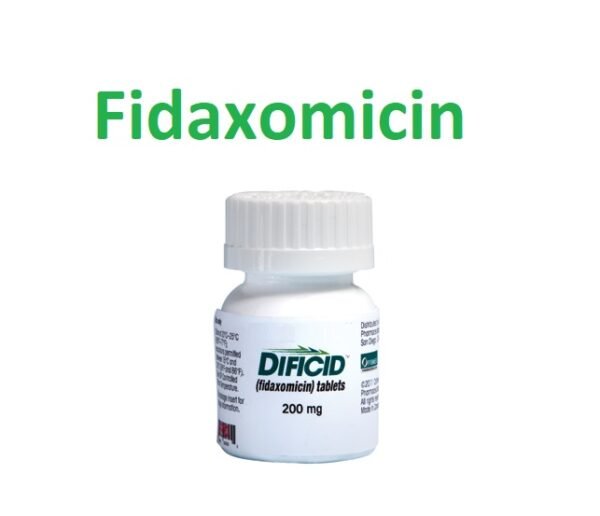An innovative macrolide antibiotic with low systemic absorption is fidaxomicin (Dificid). It is used to treat gastrointestinal illnesses brought on by susceptible microorganisms. Treatment for infections brought on by Clostridioides difficile frequently uses this.
Fidaxomicin Uses:
- It is prescribed for adults to treat infections brought on by Clostridioides (formerly Clostridium) difficile infection (CDI).
Note:
- Fidaxomicin is advised in the following situations according to the 2017 IDSA (Infectious Diseases Society of America) and SHEA (Society for Healthcare Epidemiology of America) guidelines for Clostridioides difficile infection in adults and children:
- Initial episode of CDI including non-severe and severe infection,
- first recurrence if initially treated with vancomycin, and
- second or subsequent recurrences.
Fidaxomicin (Dificid) dose in Adults
Fidaxomicin (Dificid) dose for the treatment of Clostridioides difficile infection (CDI):
- For 10 days, take 200 mg orally twice each day.
Note:
- For the initial episode of non-severe CDI (WBC 15,000 cells/mm3 and serum creatinine 1.5 mg/dL) and severe CDI (WBC >15,000 cells/mm3 and serum creatinine 1.5 mg/dL), fidaxomicin is advised as a treatment option. It is also advised for the first recurrence following initial treatment with vancomycin as well as second or subsequent recurrences.
- Criteria for disease severity should not replace clinical judgement and is based on expert opinion.
Dose in Children:
Not indicated
Fidaxomicin Pregnancy Risk Category: B
- The drug is very well absorbed systemically, which limits the possibility of fetal drug exposure.
Fidaxomicin use during breastfeeding:
- It is unknown if the drug will be excreted into breastmilk.
- It is unlikely that the drug will be excreted into breastmilk, as it has minimal systemic exposure.
- Manufacturers recommend that you weigh the benefits and risks of drug exposure for the mother and infant.
Dose in Kidney Disease:
Adjustment in the dose is not required because of minimal systemic absorption.
Dose in Liver disease:
The manufacturer has not recommended any adjustment in the dose, however, since the drug has minimal systemic absorption, dose adjustment is not required.
Common Side Effects of Fidaxomicin:
-
Gastrointestinal:
- Nausea
Less Common Side Effects of Fidaxomicin:
-
Gastrointestinal:
- Gastrointestinal hemorrhage
- Abdominal pain
- Vomiting
-
Hematologic & oncologic:
- Anemia
- Neutropenia
Contraindications to Fidaxomicin:
- Allergy to fidaxomicin and any component of this formulation
Warnings and precautions
-
Hypersensitivity
- Angioedema, which can occur in the mouth, throat, or face due to drug allergic reactions, may include angioedema, shortness, itching, and rash.
- If severe reactions are observed, treatment must be stopped and the appropriate therapy instituted.
-
Allergy to Macrolide
- Patients with an allergic reaction to macrolides should use it with caution as there is a high risk of hypersensitivity.
Fidaxomicin: Drug Interaction
Note: Drug Interaction Categories:
- Risk Factor C: Monitor When Using Combination
- Risk Factor D: Consider Treatment Modification
- Risk Factor X: Avoid Concomitant Use
Risk Factor C (Monitor therapy) |
|
| Lactobacillus and Estriol | The therapeutic effects of Lactobacillus and Estriol may be reduced by antibiotics. |
Risk Factor D (Consider therapy modification) |
|
| Sodium Picosulfate | Antibiotics may reduce Sodium Picosulfate's therapeutic impact. Management: Patients who have recently used or are now taking an antibiotic should think about utilising an alternative solution for bowel cleansing prior to a colonoscopy. |
Risk Factor X (Avoid combination) |
|
| Mizolastine | .The serum levels of Mizolastine may rise in response to macrolide antibiotics. |
Monitoring parameters:
None mentioned. Monitor the response to therapy.
How to administer Fidaxomicin?
The drug may be administered with or without food.
Mechanism of action of Fidaxomicin:
It is a bactericidal medication that causes cell death in susceptible organisms, including C. difficile. This inhibits the synthesis of bacterial proteins.
Absorption:
- Orally, it is only minimally absorbable
Distribution:
- It is mostly restricted to the gastrointestinal tract. The fecal concentration of active drugs or their metabolites is much higher than the serum.
Metabolism:
- It is hydrolyzed in the intestine to a less active metabolite (OP-1118).
Excretion:
- Over 92% of the drug is excreted as unchanged drug or metabolites in feces.
- As metabolites, less than 1% of urine is excreted.
International Brand Names of Fidaxomicin:
- Dificid
- Dificlir
Fidaxomicin Brand Names in Pakistan:
No Brands Available in Pakistan.







